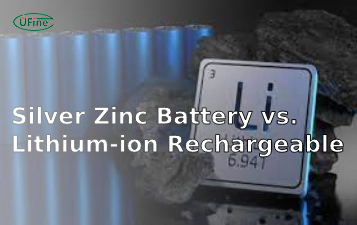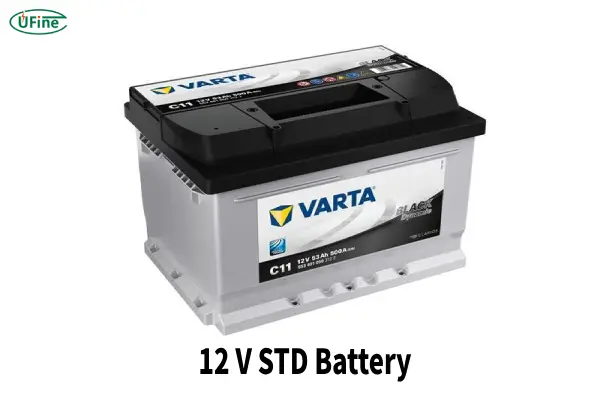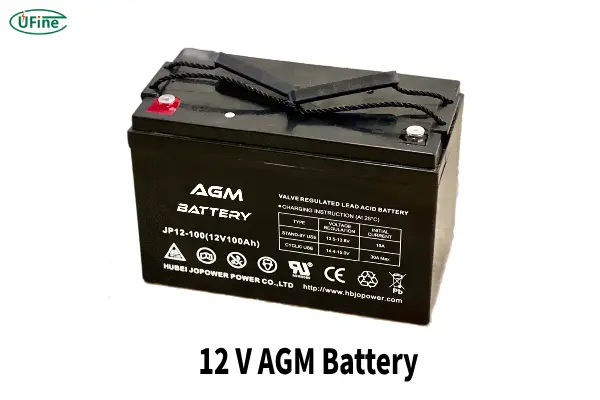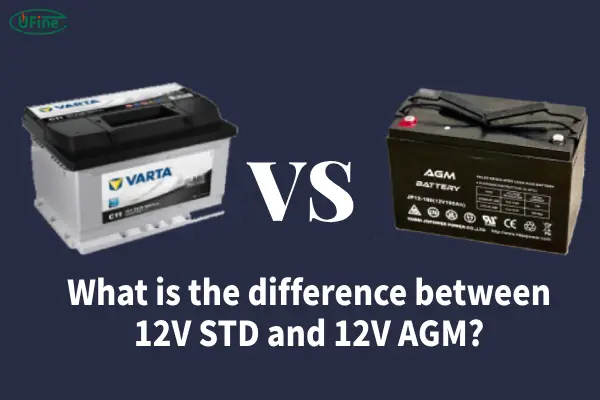
- Part 1. What is an STD battery?
- Part 2. STD battery Pros and Cons
- Part 3. What is an AGM battery?
- Part 4. AGM battery Pros and Cons
- Part 5. What is the difference between 12V STD and 12V AGM?
- Part 6. 12V STD and 12V AGM battery: which is better?
- Part 7. Can 12V AGM replace 12V STD battery?
- Part 8. How to identify whether your battery is STD or AGM?
- Part 9. Can STD and AGM batteries use the same charger?
- Part 10. Is a flooded battery considered STD or AGM?
- Part 11. Beyond STD and AGM: Why lithium batteries are the future
- Part 11. About Ufine Battery
In short: 12V STD batteries are affordable but require maintenance, while 12V AGM batteries are sealed, maintenance-free, and deliver better performance—but at a higher price.
Part 1. What is an STD battery?
An STD battery, or standard lead-acid battery, is like the trusty old friend you can always count on. It consists of lead dioxide (PbO2) as the positive plate, sponge lead (Pb) as the negative plate, and sulfuric acid (H2SO4) as the electrolyte. This battery type has been around for decades, powering everything from cars to backup generators.
Structure and Working Principle
The STD battery operates through a chemical reaction between the lead plates and the electrolyte. This process generates electrical energy when the battery discharges. After a long day on the road or a heavy work session, when you plug it in to recharge, the process reverses.
Part 2. STD battery Pros and Cons
1 Pros:
- Cost-Effective: If you’re on a budget, STD batteries are typically more affordable, making them a go-to for everyday vehicles.
- Availability: You can find these batteries almost anywhere—auto parts stores, online retailers, and local garages.
- Reliable Performance: With years of proven performance, they get the job done for standard applications.
2 Cons:
- Maintenance Required: Like an old car needing regular oil changes, these batteries need maintenance. You must check water levels and clean terminals regularly.
- Slower Recharge Times: If you’re in a rush, waiting for your battery to charge can be frustrating.
- Risk of Spillage: Being liquid-filled means there’s a risk of spills if the battery is damaged, which can be hazardous.
Part 3. What is an AGM battery?
AGM batteries are like the high-tech companion that comes with all the latest features. They use a unique design that absorbs the electrolyte in a glass mat, preventing leaks and making them safer and more efficient.
Structure and Working Principle
The lead plates are soaked in an immobilized electrolyte, allowing for faster charging and deeper discharges. Think about a boat enthusiast ready for an adventure on the water. With an AGM battery, you can trust that your electronics, from navigation systems to fish finders, will stay powered throughout your journey.
Part 4. AGM battery Pros and Cons
1 Pros:
- Maintenance-Free: With an AGM battery, you can hit the road without worrying about regular checks.
- Superior Performance: These batteries can be deeply discharged without damage, perfect for high-energy uses like RVs or off-grid solar systems.
- Robust Construction: They are designed to withstand shocks and vibrations, making them ideal for rough terrains.
2 Cons:
- Higher Cost: The price tag is typically higher, which can deter budget-conscious buyers.
- Temperature Sensitivity: Extreme temperatures can affect performance, so if you live in a region with harsh winters or sweltering summers, keep that in mind.
- Limited Lifespan in Over-Discharged States: If used improperly, AGM batteries can degrade faster than standard batteries.
Part 5. What is the difference between 12V STD and 12V AGM?
Understanding the differences between 12V STD and 12V AGM batteries can help you make the best choice. To help you visualize, let’s break down the differences between these two types of batteries through everyday scenarios:
- Design: STD batteries contain liquid electrolyte, while AGM batteries use absorbed electrolyte in a glass mat. STD batteries contain liquid electrolyte, which can spill if damaged. In contrast, AGM batteries are spill-proof, making them safer for mobile use.
- Maintenance: STD batteries require regular water level checks; AGM batteries are maintenance-free. Imagine you’re prepping for a road trip. With an AGM, you can focus on packing instead of checking battery water levels.
- Cost: STD batteries are typically cheaper; AGM batteries have a higher upfront cost. STD batteries are generally more affordable. If you drive an older car and need a reliable, cost-effective option, they’re perfect.
- Performance: AGM batteries charge faster and can handle deeper discharges better than STD batteries. When the weather gets chilly, AGM batteries maintain performance better than STD batteries, giving you peace of mind during those winter morning starts.
- Durability: AGM batteries are more robust and resistant to physical shocks; STD batteries are less durable. If you’re off-roading, an AGM battery will handle the bumps and shocks better than an STD battery.
- Weight :AGM batteries are often lighter than their standard counterparts due to their design, which can help with fuel efficiency in vehicles.
- Spill Resistance: AGM batteries are spill-proof, making them safer to use in various applications. Think of a family camping trip where you need to store your battery in the back of the truck. AGM batteries provide safety against leaks.
- Temperature Range: AGM batteries tend to perform better in extreme temperatures compared to STD batteries. If you live in a region with fluctuating temperatures, AGM batteries are likely to perform better year-round.
AGM VS Lithium VS Lead-Acid Battery: Comprehensive Comparison
Here’s a quick comparison between 12V STD and AGM batteries — helping you choose the best 12V battery for your car, RV, or Power Wheels.
| Feature | 12V STD (Standard Flooded Lead-Acid) | 12V AGM (Absorbent Glass Mat) |
|---|---|---|
| Internal Structure | Liquid electrolyte | Electrolyte absorbed in glass mats |
| Maintenance | Requires regular water refilling | Maintenance-free |
| Spill Risk | High – prone to leaks if tilted | Low – sealed and spill-proof |
| Vibration Resistance | Moderate | High – better suited for rough conditions |
| Cycle Life | Shorter | Longer |
| Charging Efficiency | Slower | Faster charging with lower internal resistance |
| Self-Discharge Rate | Higher | Lower |
| Position Flexibility | Must stay upright | Can be installed in various orientations |
| Cold Weather Performance | Poorer starting power in cold | Better performance in cold conditions |
| Cost | Lower upfront cost | Higher upfront cost |
| Use Cases | Basic automotive, lawn equipment | Start-stop systems, RVs, boats, solar storage |
Quick Takeaway If you want something affordable for daily driving—go with STD. If you need higher reliability, better deep-cycle performance, and no maintenance—AGM is worth the investment.
Part 6. 12V STD and 12V AGM battery: which is better?
The decision comes down to your specific needs:
- Choose 12V STD if you want a budget-friendly option for daily driving or light use. If your car is older and you don’t mind a bit of maintenance, this could be your go-to battery.
- Choose 12V AGM if you’re an adventurer. Whether you’re navigating rugged terrains in an RV or powering your boat on a weekend getaway, the reliability and maintenance-free aspect of AGM batteries can enhance your experience.
Part 7. Can 12V AGM replace 12V STD battery?
Yes, you can generally replace a 12V STD battery with a 12V AGM battery, but be cautious. Ensure compatibility with your device’s charging system. If you plan to use AGM in a vehicle designed for STD batteries, check the manufacturer’s recommendations to prevent any potential issues.
Part 8. How to identify whether your battery is STD or AGM?
To determine whether your battery is a Standard (STD) flooded lead-acid battery or an Absorbent Glass Mat (AGM) battery, begin by examining the label or specifications printed on the battery casing. Manufacturers typically indicate the battery type using terms such as:
- “Flooded,” “Wet Cell,” or “Lead-Acid” – These refer to conventional STD batteries.
- “AGM” or “Absorbent Glass Mat” – This explicitly denotes an AGM battery.
In terms of physical design, STD flooded batteries often have removable caps for maintenance and visible vent holes, while AGM batteries are sealed, maintenance-free, and generally have a flat top with no access to the internal electrolyte. If the label is missing or unclear, refer to the battery’s part number or consult the manufacturer’s datasheet or website for exact classification.
Part 9. Can STD and AGM batteries use the same charger?
Not always. While some advanced battery chargers are designed with selectable modes for different battery chemistries, traditional chargers may not be suitable for both STD and AGM batteries.
AGM batteries are more sensitive to charging voltages and typically require a lower float voltage and controlled charging cycle to prevent overheating or overcharging. Using an incorrect charger on an AGM battery can lead to reduced performance or permanent damage.
Best practice:
- Use a smart charger with dedicated settings for AGM and STD batteries.
- Always follow the battery manufacturer’s charging recommendations.
- If your charger lacks AGM compatibility, avoid using it on AGM batteries.
Part 10. Is a flooded battery considered STD or AGM?
A flooded battery is classified as a Standard (STD) lead-acid battery. It contains a liquid electrolyte that freely moves within the cells and requires periodic maintenance, such as topping off with distilled water.
In contrast, AGM batteries are not flooded. They use a fiberglass separator to hold the electrolyte in place, allowing the battery to be sealed and maintenance-free. This difference in design results in distinct performance, charging, and durability characteristics between flooded (STD) and AGM batteries.
Part 11. Beyond STD and AGM: Why lithium batteries are the future
While STD and AGM batteries have served for decades, lithium batteries are rapidly becoming the modern alternative.
Here’s why many users are switching:
- Lightweight & Compact: Up to 60% lighter than lead-acid.
- Long Lifespan: Up to 10 years or 3000+ cycles.
- Fast Charging: Fully recharges in 1–2 hours.
- Zero Maintenance: No acid, no water, no corrosion.
- Safe & Eco-Friendly: Built-in BMS prevents overcharge and overheating.
If you’re upgrading your power system or looking for a long-term investment, lithium batteries offer superior performance, safety, and efficiency.
Part 11. About Ufine Battery
Ufine Battery is a professional custom lithium battery manufacturer in China, providing reliable 12V LiFePO4 and lithium-ion battery packs for automotive, solar, marine, and industrial applications.
We specialize in replacing traditional lead-acid and AGM systems with lightweight, high-efficiency lithium solutions.
Whether you need a 12V lithium battery for Power Wheels, RVs, or solar storage, our engineering team can customize a battery pack to fit your exact requirements.
Contact Ufine Battery today to explore safe, powerful, and long-lasting lithium battery solutions.
Related Tags:
More Articles

What is the Difference Between Silver Zinc Battery vs. Lithium-ion Rechargeable?
Compare silver zinc and lithium-ion rechargeable batteries: energy density, cycle life, safety, cost, and uses in drones, medical devices, EVs, and electronics.
What are Watts and Watt Hours in Battery?
Understand watt vs watt-hour in batteries: key differences, how to calculate capacity, and why they matter. Includes free comparison table.
Best 10 Blood Pressure Monitor Battery Review: Finding the Most Reliable
Are you looking for a reliable Blood Pressure Monitor battery? Here is a complete guide with the top 10 best blood pressure monitor batteries.
Bluetooth Headphone Battery Guide: All You Need to Know
Maximize headphone battery life with expert tips! Learn how to charge, check, troubleshoot, and choose the best bluetooth headphone battery in 2025.
LiFePO4 Battery VS. Lithium-ion Polymer Battery: Which One Is Best?
Comprehensive comparison of LiFePO4 vs Lithium Ion Polymer batteries: energy density, safety, lifespan, cost. Find out which battery suits your needs in 2025.





